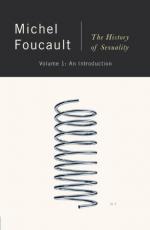
|
| Name: _________________________ | Period: ___________________ |
This quiz consists of 5 multiple choice and 5 short answer questions through Part 2, Chapter 2, The Perverse Implantation.
Multiple Choice Questions
1. According to Foucault, what has happened to our "will to knowledge" regarding sexuality?
(a) It has created a science of sexuality.
(b) It has shown us the path to liberation.
(c) It came to a halt in the face of taboo.
(d) It has created an understanding of our perversions.
2. Which public institution undertook to classify and manage all forms of "incomplete" sexual practices?
(a) The law.
(b) Medicine.
(c) The church.
(d) The government.
3. Which of the following is NOT one of the doubts Foucault expresses against the "repressive hypothesis?"
(a) Does the repression of sexuality lead to a concentration of power?
(b) Is sexual repression undone by discourse?
(c) Is sexual repression a historical fact?
(d) Is the analysis of the repression of sexuality a component of the repression itself?
4. What reason does Foucault give for modern society being perverse?
(a) It is the result of erecting too large a barrier against sexuality.
(b) It is from a backlash provoked by hypocrisy.
(c) It was created by the imbalance of power mechanisms and sexuality.
(d) It is in fact, directly, perverse.
5. Which of the following is NOT one of Foucault's statements regarding the discourses around sexuality of children?
(a) They are hierarchized and interlocking.
(b) They are articulated around power relations.
(c) They replaced a former way of speaking about sex.
(d) They are the exclusive domain of adults.
Short Answer Questions
1. What can be said about the family unit and educational institutes in the nineteenth century?
2. Which of the following is NOT listed as one of the accepted ways to free oneself from the effects of sexual repression?
3. What does Foucault say is the "speaker's benefit?"
4. What explanation does Foucault say is historically applied to the evolution of sexuality after the fact?
5. What does Foucault mean by "we other Victorians?"
|
This section contains 459 words (approx. 2 pages at 300 words per page) |

|




